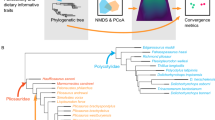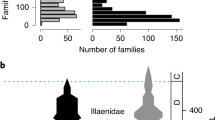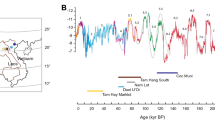Abstract
The colonization of land was one of the major events in Earth history, leading to the expansion of life and laying the foundations for the modern biosphere. We examined trace fossils, the record of the activities of past life, to understand how animals diversify both behaviourally and ecologically when colonizing new habitats. The faunal invasion of land was preceded by excursions of benthic animals into very shallow, marginal marine environments during the latest Ediacaran period and culminated in widespread colonization of non-marine niches by the end of the Carboniferous period. Trace fossil evidence for the colonization of new environments shows repeated early burst patterns of maximal ichnodisparity (the degree of difference among basic trace fossil architectural designs), ecospace occupation and level of ecosystem engineering prior to maximal ichnodiversity. Similarities across different environments in the types of behavioural programme employed (as represented by different trace fossils), modes of life present and the ways in which animals impacted their environments suggest constraints on behavioural and ecological diversification. The early burst patterns have the hallmark of novelty events. The underlying drivers of these events were probably the extrinsic limitation of available ecospace and intrinsic controls of genomic and developmental plasticity that enabled trace-maker morphological and behavioural novelty.
This is a preview of subscription content, access via your institution
Access options
Access Nature and 54 other Nature Portfolio journals
Get Nature+, our best-value online-access subscription
$29.99 / 30 days
cancel any time
Subscribe to this journal
Receive 12 digital issues and online access to articles
$119.00 per year
only $9.92 per issue
Buy this article
- Purchase on Springer Link
- Instant access to full article PDF
Prices may be subject to local taxes which are calculated during checkout




Similar content being viewed by others
References
Maynard Smith, J . & Szathmáry, E. The Major Transitions in Evolution (WH Freeman, 1995).
Battistuzzi, F. U., Feijao, A. & Hedges, S. B. A genomic timescale of prokaryote evolution: insights into the origin of methanogenesis, phototrophy, and the colonization of land. BMC Evol. Biol. 4, 44 (2004).
Davies, N. S., Liu, A. G., Gibling, M. R. & Miller, R. F. Resolving MISS conceptions and misconceptions: a geological approach to sedimentary surface textures generated by microbial and abiotic processes. Earth-Sci. Rev. 154, 210–246 (2016).
Horodyski, R. J. & Knauth, L. P. Life on land in the Precambrian. Science 263, 494–498 (1994).
Strother, P. K., Battison, L., Brasier, M. D. & Wellman, C. H. Earth’s earliest non-marine eukaryotes. Nature 473, 505–509 (2011).
Wellman, C. H. & Strother, P. K. The terrestrial biota prior to the origin of land plants (embryophytes): a review of the evidence. Palaeontology 58, 601–627 (2015).
Watanabe, Y., Martini, J. E. J. & Ohmoto, H. Geochemical evidence for terrestrial ecosystems 2.6 billion years ago. Nature 408, 574–578 (2000).
Knauth, L. P. & Kennedy, M. J. The late Precambrian greening of the Earth. Nature 460, 728–732 (2009).
Kennedy, M., Droser, M., Mayer, L. M., Pevear, D. & Mrofka, D. Late Precambrian oxygenation; inception of the clay mineral factory. Science 311, 1446–1449 (2006).
McMahon, W. J., Davies, N. S. & Went, D. J. Negligible microbial matground influence on pre-vegetation river functioning: evidence from the Ediacaran–Lower Cambrian Series Rouge, France. Precambrian Res. 292, 13–34 (2017).
Horodyskyj, L. B., White, T. S. & Kump, L. R. Substantial biologically mediated phosphorus depletion from the surface of a Middle Cambrian paleosol. Geology 40, 503–506 (2012).
Rubinstein, C. V., Gerrienne, P., de la Puente, G. S., Astini, R. A. & Steemans, P. Early Middle Ordovician evidence for land plants in Argentina (eastern Gondwana). New Phytol. 188, 365–369 (2010).
Retallack, G. J. Ediacaran life on land. Nature 493, 89–92 (2013).
Minter, N. J. et al. in The Trace-Fossil Record of Major Evolutionary Events Vol. 1 (eds Mángano, M. G. & Buatois, L. A. ) 157–204 (Springer, 2016).
Rota-Stabelli, O., Daley, A. C. & Pisani, D. Molecular timetrees reveal a Cambrian colonization of land and a new scenario for ecdysozoan evolution. Curr. Biol. 23, 392–398 (2013).
Lozano-Fernandez, J. et al. A molecular palaeobiological exploration of arthropod terrestrialization. Phil. Trans. R. Soc. B 317, 20150133 (2016).
Fernández, R., Edgecombe, G. D. & Giribet, G. Exploring phylogenetic relationships within Myriapoda and the effects of matrix composition and occupancy on phylogenomic reconstruction. Syst. Biol. 65, 871–889 (2016).
Misof, B. et al. Phylogenomics resolves the timing and pattern of insect evolution. Science 346, 763–767 (2014).
Buatois, L. A. & Mángano, M. G. Ecospace utilization, paleoenvironmental trends, and the evolution of early nonmarine biotas. Geology 21, 595–598 (1993).
MacNaughton, R. B. et al. First steps on land: arthropod trackways in Cambrian–Ordovician eolian sandstone, southeastern Ontario, Canada. Geology 30, 391–394 (2002).
Miller, M. F. & Labandeira, C. C. Slow crawl across the salinity divide: delayed colonization of freshwater ecosystems by invertebrates. GSA Today 12, 4–10 (2002).
Braddy, S. J. Ichnological evidence for the arthropod invasion of land. Foss. Strat. 51, 136–140 (2004).
Jones, C. G., Lawton, J. H. & Shachak, M. Organisms as ecosystem engineers. Oikos 69, 373–386 (1994).
Erwin, D. H. Macroevolution of ecosystem engineering, niche construction and diversity. Trends Ecol. Evol. 23, 304–310 (2008).
Foote, M. Discordance and concordance between morphological and taxonomic diversity. Paleobiology 19, 185–204 (1993).
Erwin, D. H. Disparity: morphological pattern and developmental context. Palaeontology 50, 57–73 (2007).
Benton, M. J. Exploring macroevolution using modern and fossil data. Proc. R. Soc. B 282, 20150569 (2015).
Buatois, L. A., Mángano, M. G., Olea, R. A. & Wilson, M. A. Decoupled evolution of soft and hard substrate communities during the Cambrian Explosion and Great Ordovician Biodiversification Event. Proc. Natl Acad. Sci. USA 113, 6945–6948 (2016).
Minter, N. J ., Buatois, L. A & Mángano, M. G . in The Trace-Fossil Record of Major Evolutionary Events Vol. 1 (eds Mángano, M. G. & Buatois, L. A. ) 1–26 (Springer, 2016).
Benton, M. J. Palaeodiversity and formation counts: redundancy or bias? Palaeontology 58, 1003–1029 (2015).
Johnson, E. W., Briggs, D. E. G., Suthren, R. J., Wright, J. L. & Tunnicliff, S. P. Non-marine arthropod traces from the subaerial Ordovician Borrowdale Volcanic Group, English Lake District. Geol. Mag. 131, 395–406 (1994).
Labandeira, C. C. Invasion of the continents: cyanobacterial crusts to tree-inhabiting arthropods. Trends Ecol. Evol. 20, 253–262 (2005).
Morrissey, L. B., Braddy, S. J., Dodd, C., Higgs, K. T. & Williams, B. P. J. Trace fossils and palaeoenvironments of the Middle Devonian Caherbla Group, Dingle Peninsula, southwest Ireland. Geol. J. 47, 1–29 (2012).
Walker, E. F. Arthropod ichnofauna of the Old Red Sandstone at Dunure and Montrose, Scotland. Earth Env. Sci. T. R. So. 76, 287–297 (1985).
Mángano, M. G., Buatois, L. A., Astini, R. & Rindsberg, A. K. Trilobites in Early Cambrian tidal flats and the landward expansion of the Cambrian explosion. Geology 42, 143–146 (2014).
Davies, N. S., Sansom, I. J., Albanesi, G. L. & Cespedes, R. Ichnology, palaeoecology and taphonomy of an Ordovician vertebrate habitat: the Anzaldo Formation, central Bolivia. Palaeogeogr. Palaeoclimatol. Palaeoecol. 249, 18–35 (2007).
Shear, W. A. & Kukalová-Peck, J. The ecology of Paleozoic terrestrial arthropods: the fossil evidence. Can. J. Zool. 68, 1807‒1834 (1990).
Wright, J. L., Quinn, L., Briggs, D. E. G. & Williams, S. H. A subaerial arthropod trackway from the Upper Silurian Clam Bank Formation of Newfoundland. Can. J. Earth Sci. 32, 304–313 (1995).
Marriott, S. B., Morrissey, L. B. & Hillier, R. D. Trace fossil assemblages in Upper Silurian tuff beds: evidence of biodiversity in the Old Red Sandstone of southwest Wales, UK. Palaeogeogr. Palaeoclimatol. Palaeoecol. 274, 160–172 (2009).
Minter, N. J. et al. in The Trace-Fossil Record of Major Evolutionary Events Vol. 1 (eds Mángano, M. G. & Buatois, L. A. ) 205–324 (Springer, 2016).
Davies, N. S., Sansom, I. J. & Turner, P. Trace fossils and paleoenvironments of a Late Silurian marginal-marine/alluvial system: the Ringerike Group (Lower Old Red Sandstone), Oslo Region, Norway. Palaios 21, 46–62 (2006).
Buatois, L. A. & Mángano, M. G . in Microbial Mats in Siliciclastic Sediments SEPM Special Publication 101 (eds Noffke, N. & Chafez, H. ) 15–28 (Society for Sedimentary Geology, 2012).
Gibling, M. R. & Davies, N. S. Palaeozoic landscapes shaped by plant evolution. Nat. Geosci. 5, 99–105 (2012).
Corenblit, D ., Davies, N. S ., Steiger, J ., Gibling, M. R & Bornette, G. Considering river structure and stability in the light of evolution: feedbacks between riparian vegetation and hydrogeomorphology. Earth Surf. Proc. Land. 40, 189–207 (2015).
Davies, N. S. & Gibling, M. R. The sedimentary record of Carboniferous rivers: continuing influence of land plant evolution on alluvial processes and Palaeozoic ecosystems. Earth Sci. Rev. 120, 40–79 (2013).
Ward, J. V., Tockner, K., Arscott, D. B & Claret, C. Riverine landscape diversity. Freshwater Biol. 47, 517–539 (2002).
Erwin, D. H. A preliminary classification of evolutionary radiations. Hist. Biol. 6, 133–147 (1992).
Ruta, M., Angielczyk, K. D., Fröbisch, J. & Benton, M. J. Decoupling of morphological disparity and taxic diversity during the adaptive radiation of the anomodont therapsids. Proc. R. Soc. B 280, 20131071 (2013).
Chloe, J. C & Crespi, B. J. The Evolution of Social Behavior in Insects and Arachnids (Cambridge Univ. Press, 1997).
Buatois, L. A., Labandeira, C. C., Mángano, M. G., Cohen, A. & Voigt, S. in The Trace-Fossil Record of Major Evolutionary Events Vol. 2 (eds Mángano, M. G. & Buatois, L. A. ) 179–263 (Springer, 2016).
Bertling, M. et al. Names for trace fossils: a uniform approach. Lethaia 39, 265–286 (2006).
Minter, N. J., Braddy, S. J. & Davis, R. B. Between a rock and a hard place: arthropod trackways and ichnotaxonomy. Lethaia 40, 365–375 (2007).
Knaust, D. in Trace-Fossils as Indicators of Sedimentary Environments (eds Knaust, D. & Bromley, R. G. ) 79–101 (Elsevier, 2012).
Alroy, J. et al. Effects of sampling standardization on estimates of Phanerozoic marine diversification. Proc. Natl Acad. Sci. USA 98, 6261–6266 (2001).
Smith, A. B. & McGowan, A. J. The shape of the Phanerozoic marine palaeodiversity curve: how much can be predicted from the sedimentary rock record of Western Europe? Palaeontology 50, 765–774 (2007).
Lloyd, G. T. A refined modelling approach to assess the influence of sampling on palaeodiversity curves: new support for declining Cretaceous dinosaur richness. Biol. Lett. 8, 123–126 (2012).
Sakamoto, M., Venditti, C. & Benton, M. J. ‘Residual diversity estimates’ do not correct for sampling bias in palaeodiversity data. Methods Ecol. Evol. 8, 453–459 (2017).
Ronov, A. B., Khain, V. E., Balukhovsky, A. N. & Seslavinsky, K. B. Quantitative analysis of Phanerozoic sedimentation. Sediment. Geol. 25, 311–325 (1980).
Peters, S. E. Macrostratigraphy of North America. J. Geol. 114, 391–412 (2006).
Buatois, L. A., Wisshak, M., Wilson, M. A. & Mángano, M. G. Categories of architectural designs in trace fossils: a measure of ichnodisparity. Earth-Sci. Rev. 164, 102–181 (2017).
Bromley, R. G. Trace Fossils: Biology, Taphonomy and Applications (Chapman and Hall, 1996).
Bambach, R. K., Bush, A. M. & Erwin, D. H. Autecology and the filling of ecospace: key metazoan radiations. Palaeontology 50, 1–22 (2007).
Bush, A. M., Bambach, R. K. & Daley, G. M. Changes in theoretical ecospace utilization in marine fossil assemblages between the mid-Paleozoic and late Cenozoic. Paleobiology 33, 76–97 (2007).
Ausich, W. I. & Bottjer, D. J. Tiering in suspension-feeding communities on soft substrata throughout the Phanerozoic. Science 216, 173–174 (1982).
Bottjer, D. J. & Ausich, W. I. Phanerozoic development of tiering in soft-substrate suspension-feeding communities. Paleobiology 12, 400–420 (1986).
Mángano, M. G. & Buatois, L. A. Decoupling of body-plan diversification and ecological structuring during the Ediacaran–Cambrian transition: evolutionary and geobiological feedbacks. Proc. R. Soc. B 281, 20140038 (2014).
Buatois, L. A & Mángano, M. G. Ichnology: Organism‒Substrate Interactions in Space and Time (Cambridge Univ. Press, 2011).
François, F., Poggiale, J.-C., Durbec, J.-P. & Stora, G. A new approach for the modeling of sediment reworking induced by a macrobenthic community. Acta Biotheor. 45, 295–319 (1997).
François, F., Gerino, M., Stora, G., Durbec, J.-P. & Poggiale, J.-C. Functional approach to sediment reworking by gallery-forming macrobenthic animals: modeling and application with the polychaete Nereis diversicolor . Mar. Ecol. Prog. Ser. 229, 127–136 (2002).
Solan, M. & Wigham, B. D. in Interactions Between Macro- and Microorganisms in Marine Sediments (eds Kristensen, E., Haese, R. R. & Kostka, J. E. ) 105–124 (Coastal and Estuarine Studies 60, American Geophysical Union, 2005).
Buatois, L. A. & Mángano, M. G. in Trace Fossils: Concepts, Problems, Prospects (ed. Miller, W. III ) 285–323 (Elsevier, 2007).
Buatois, L. A., Mángano, M. G., Maples, C. G. & Lanier, W. P. The paradox of nonmarine ichnofaunas in tidal rhythmites: integrating sedimentologic and ichnologic data from the Late Carboniferous of eastern Kansas, USA. Palaios 12, 467–481 (1997).
Acknowledgements
Financial support for the initial part of this project was provided to N.J.M. through a Government of Canada Post-doctoral Research Fellowship under the Canadian Commonwealth Scholarship Program. Additional funding was provided by the Natural Sciences and Engineering Research Council (NSERC) Discovery Grants 311726-05/08/15 and 311727-05/08/13 (to L.A.B. and M.G.M., respectively). M.R.G also acknowledges funding from an NSERC Discovery Grant. This is Earth Sciences Sector contribution number 20160255 and contribution 314 of the Evolution of Terrestrial Ecosystems Consortium of the National Museum of Natural History, Washington DC. We are grateful for the constructive comments of R. Garwood, which improved the manuscript.
Author information
Authors and Affiliations
Contributions
N.J.M., L.A.B. and M.G.M. conceived the study. N.J.M., L.A.B., M.G.M., N.S.D., M.R.G., R.B.M. and C.C.L. contributed data to the analysis. N.J.M. performed the analysis and analysed the results. N.J.M. led the writing of the paper, with input from the other authors.
Corresponding author
Ethics declarations
Competing interests
The authors declare no competing financial interests.
Supplementary information
Supplementary Information
Supplementary Figures 1–6: patterns of colonization of subaerial coastal, subaqueous alluvial, aeolian, subaqueous lacustrine, marginal lacustrine, and ephemeral lacustrine environments. Supplementary Figure 7: comparison of patterns with data pooled at different temporal resolutions. Supplementary Figures 8–10: graphical correlations between diversification metrics and sampling measures. Supplementary Figure 11: numbers of ichnogenera per architectural design occupying different tiers. Supplementary Figure 12: principal co-ordinate analysis. Supplementary Tables 1,2: Statistical analyses of correlations between sampling measures and diversification metrics. (PDF 2070 kb)
Supplementary Table 3
Supplementary dataset of ichnogenera found globally by geological period within each environmental category. (XLSX 71 kb)
Supplementary Table 4
Supplementary dataset with presence–absence matrix of architectural designs. (XLSX 11 kb)
Supplementary Table 5
Supplementary dataset with presence–absence matrix of modes of life. (XLSX 40 kb)
Supplementary Table 6
Supplementary dataset with presence–absence matrix of impacts upon the sediment. (XLSX 40 kb)
Rights and permissions
About this article
Cite this article
Minter, N., Buatois, L., Mángano, M. et al. Early bursts of diversification defined the faunal colonization of land. Nat Ecol Evol 1, 0175 (2017). https://doi.org/10.1038/s41559-017-0175
Received:
Accepted:
Published:
DOI: https://doi.org/10.1038/s41559-017-0175
This article is cited by
-
Increased habitat segregation at the dawn of the Phanerozoic revealed by correspondence analysis of bioturbation
Scientific Reports (2023)
-
Early onset of urea synthesis and ammonia detoxification pathways in three terrestrially developing frogs
Journal of Comparative Physiology B (2023)
-
Assessing the expansion of the Cambrian Agronomic Revolution into fan-delta environments
Scientific Reports (2022)
-
Complex marine bioturbation ecosystem engineering behaviors persisted in the wake of the end-Permian mass extinction
Scientific Reports (2020)
-
Sediment disturbance by Ediacaran bulldozers and the roots of the Cambrian explosion
Scientific Reports (2018)



